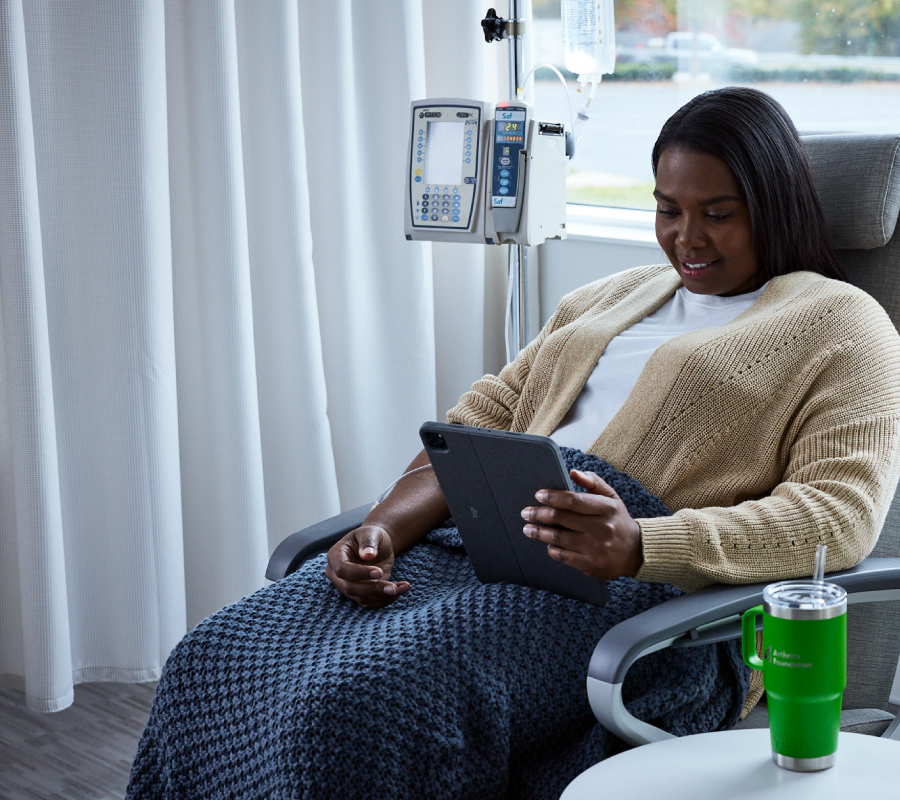Biologics
Biologics are powerful drugs that may slow or stop inflammation that can damage joints and organs in arthritis and other inflammatory diseases.
By Linda Rath | Updated Sept. 3, 2022
Biologics are a subset of a class of medications called disease-modifying antirheumatic drugs (DMARDs). Nonbiologic, or conventional, DMARDs, such as methotrexate, are drugs composed of small molecules made from chemicals in a lab. Biologics are large molecules produced in living cells. Both help protect against the effects of inflammation, but in different ways.
Conventional DMARDs suppress the overall immune system, whereas biologics block specific parts of the immune system, such as proteins that promote inflammation. Biologics are more complex and harder to make than conventional DMARDs and cost much more. And unlike small-molecule drugs, they don’t come in pill form. Some are in the form of a self-injection using a prefilled vial and autoinjector. Others are given by intravenous (IV) infusion in a doctor’s office or clinic.
Many people never need biologic DMARDs because conventional DMARDs control their disease well. The American College of Rheumatology recommends methotrexate over a biologic as the first choice for most people with inflammatory autoimmune diseases like rheumatoid arthritis and psoriatic arthritis. If methotrexate or another conventional DMARD isn’t effective, your doctor may switch you to a biologic or a biosimilar, a drug nearly identical to a biologic.
How Biologics Work
Different biologics target different parts of the immune system that fuel inflammation. Tumor necrosis factor (TNF) inhibitors, for example, block an inflammatory protein called TNF, while other drugs block pro-inflammatory B cells or T cells. Even with several options, drug selection can be difficult because inflammatory diseases are often driven by many factors. That’s why one biologic may work well for some people but not for others. And a biologic may work for you at first but then stop working after a while. If the first one you try doesn’t work or stops working for you, your doctor will likely suggest a different biologic.
Benefits and Risks
Biologic drugs are life-changing for many people living with autoimmune forms of arthritis, especially children. But like all DMARDs, they suppress the immune system and may increase your risks for certain conditions, including serious infections and cancers. Rheumatic diseases also raise the risks of serious infections and certain cancers, however, so be sure to discuss the benefits and risks and any concerns you have with your doctor. There are four types of biologics, each with a unique inflammatory target and its own risks and benefits.
1. Tumor Necrosis Factor-α (TNF) Inhibitors
Also called TNF blockers or anti-TNFs, the first of these included: adalimumab (Humira), certolizumab pegol (Cimzia), etanercept (Enbrel), golimumab (Simponi, Simponi Aria) and infliximab (Remicade). A number of biosimilars have also been launched, including those for adalimumab and for infliximab (Avsola, Inflectra, Renflexis).
Benefits: These are the most widely used biologics for inflammatory autoimmune arthritis. They reduce inflammation relatively quickly and can help prevent long-term joint damage. When a TNF blocker is effective, you should see some improvement in your symptoms in two to 12 weeks.
Risks:
- The risk of infections is small but higher in the first six months after starting a TNF blocker, especially for people who are older or have a history of infections, and then decreases. Risk seems to vary by the brand of drug and type of infection, but in general the risk is double that of people not taking biologics, especially in those who are also taking another DMARD or corticosteroid. Tuberculosis (TB) and fungal infections are particularly common. In one study, the incidence of TB was 18 times higher in people using TNF blockers than the general population. The risk was highest with adalimumab and certolizumab and lower with etanercept.
- Long-term use of anti-TNFs may increase the risk of certain cancers, especially skin cancer and lymphoma, although study results are conflicting.
- Adalimumab may worsen pre-existing heart failure or multiple sclerosis.
- The anti-inflammatory effect of anti-TNF drugs can diminish over time because some people form antibodies against the drug; using methotrexate with the biologic may make this less likely.
- Etanercept, adalimumab, golimumab and infliximab are approved for use in children. The FDA has warned they may increase the risk of certain types of cancer in kids and teens, especially those taking the drugs for inflammatory bowel disease, but studies have shown mixed results.
2. B-Cell Inhibitors
These include belimumab (Benlysta) and rituximab (Rituxan), and rituximab biosimilars Riabni, Ruxience and Truxima.
Benefits: Belimumab is FDA-approved for lupus and lupus nephritis in adults and children aged 5 to 17. It’s used along with standard treatments, such as corticosteroids and hydroxychloroquine. Rituximab may be used to treat rheumatoid arthritis when methotrexate or a TNF blocker hasn’t proved effective.
Risks:
- Reactions to B-cell inhibitor infusions can be serious, leading to changes in blood pressure, chest pain, difficulty breathing, rash, dizziness and flu-like symptoms. You’ll get medications before an infusion to help prevent these reactions.
- Belimumab increases the risk of serious, even fatal infections.
- Rituximab can reactivate hepatitis B and may be associated with progressive multifocal leukoencephalopathy, a severe brain infection.
- B-cell inhibitors aren’t safe during pregnancy and should be stopped at least six months before trying to conceive.
3. Interleukin Inhibitors
These include anakinra (Kineret), canakinumab (Ilaris), guselkumab (Tremfya), ixekizumab (Taltz), risankizumab (Skyrizi), sarilumab (Kevzara), secukinumab (Cosentyx), tocilizumab (Actemra) and ustekinumab (Stelara).
Benefits: These drugs target several different types of interleukins – inflammatory proteins produced by white cells. For example, anakinra blocks interleukin-1 (IL-1) while tocilizumab and sarilumab block IL-6. Ixekizumab and secukinumab are IL-17 inhibitors. Some drugs in this class treat rheumatoid arthritis; others are more effective for psoriatic arthritis, psoriasis or ankylosing spondylitis.
Risks: A 2019 meta-analysis of 74 randomized controlled trials involving nearly 30,000 patients showed that those taking interleukin inhibitors had a significantly higher risk of serious infections and cancer and a more than doubled risk of opportunistic infections such as TB, herpes zoster and toxoplasmosis. The study, which included every interleukin inhibitor and most inflammatory and autoimmune rheumatic diseases, also suggested that there was a greater risk of cancer with long-term interleukin inhibitor treatment.
4. Selective Co-stimulation Modulators
Abatacept (Orencia) is the only drug in this category.
Benefits: Abatacept works by blocking overactive T cells. It can be used as a first-line treatment for moderate to severe RA, but it’s usually prescribed for RA when methotrexate or other nonbiologic DMARDs aren’t effective. Some people who don’t get relief from a TNF blocker respond to abatacept. It’s also used to treat adult psoriatic arthritis and juvenile idiopathic arthritis. Joint pain, stiffness and swelling may start to improve after four to six weeks of treatment, although it may take four to six months for a full response. Abatacept may also help improve interstitial lung disease, a serious complication affecting up to 50% of people with RA.
Risks: Abatacept contributes to about the same rate of infections and cancer as other biologics but fewer hospitalizations for serious infections.
Unbranded Biologics
An unbranded biologic is identical to its brand-name biologic but without the brand name on the label. They have the same strength, dosage and method of administration as the original. It’s hoped that unbranded biologics will cost less than the branded version, just as generic small-molecule drugs are often considerably cheaper than brand-name versions.
Before You Start
- Tell your doctor if you have an active infection or have lived in places where fungal infections are common.
- Get screened for TB and hepatitis B.
- Don’t get a live vaccine, like those for chicken pox, monkey pox or measles.
Shared Decision-Making
All drugs have side effects, but for many taking a biologic, the benefits far outweigh the risks. Together, you and your doctor will choose the treatment that benefits you the most with the fewest possible side effects. You should play an active role in the decision-making process, taking costs, potential harms and your own values into account.

Stay in the Know. Live in the Yes.
Get involved with the arthritis community. Tell us a little about yourself and, based on your interests, you’ll receive emails packed with the latest information and resources to live your best life and connect with others.


